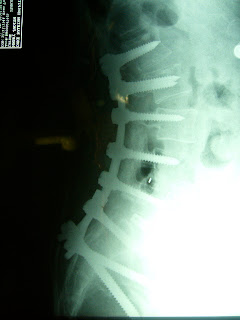who in turn have sent us other patients from that area -- which means we see usually someone from Savannah every week or so, all by word of mouth.
Judy had an L3-5 instrumentation and fusion with laminectomy done years ago, and did well until the past few years where she has developed increasing back and leg pain and trouble walking. Her disc levels above and below her previous fusion have deteriorated, and have become very tight with spinal stenosis caused by thickened ligaments, disc, and bone spurs. Her quality of life was very poor preoperatively. Her MRI confirmed the severe stenosis above and below her previous fusion (see below).
Today, I went in posteriorly through her old scar and removed the old hardware using our "Universal" hardware removal "toolbox". It is usually helpful to know what the company and model name is for the spinal hardware if you are going to be taking out someone's hardware --- then the specific wrenches needed to remove the hardware can be borrowed from the vendor, which makes hardware extraction easier, which saves crucial operating time. It is also important as a surgeon to pick hardware which is easily modified or removable. Some systems can be almost impossible to remove, which is not good.
After getting old hardware out, new hardware was installed in the old holes, and I added 2 levels above the old fusion, and one level L5S1 below. Her spine was noticably unstable especially at the L23 level above her fusion, which probably is why she was having so much pain -- the top half of her body was not well connected to the bottom!
At L5S1, due to the high loads and unstable disc space there, I added an interbody titanium TLIF (Transforaminal Lumbar Interbady Fusion) "Cage" implant along with some local bone graft to "jack up" and support that disc space, replacing the worn out disc with the spacer and graft. This helps the fusion at that critical level. I also included iliac wing instrumentation as well which helps spread load to pelvis, also increasing fusion rates.
I removed the L1 and L2 and L5 lamina, and opened up all of the nerve holes at those levels, where her lumbar stenosis (nerve pinch) was very severe.
She did very well during the surgery. Her estimated blood loss (EBL) was only 700 cc, and she received back around 250 cc of Cell Saver, and she required no transfusions of blood besides cell
saver.
We fused a total of 7 levels, and did 3 level laminectomy, and one level TLIF. Local and allograft bone graft was packed out laterally over sacral ala, and
decorticated old fusion mass and transverse processes.
Her intraoperative radiographs with the hardware in looked great, with excellent lordosis (lumbar proper curve from side view, giving a "hollow curve" in the lower back area, and a normal-appearing buttock profile)
I saw her in PACU / Recovery room an hour or so later and she was wide awake, ready to get moving without significant pain. We injected some Marcaine with Epi along the incision which helps with immediate pain management. Tomorrow she gets up and around!
Lloyd A. Hey, MD MS
Hey Clinic for Scoliosis and Spine Surgery
Raleigh NC USA
http://www.HeyClinic.com





No comments:
Post a Comment